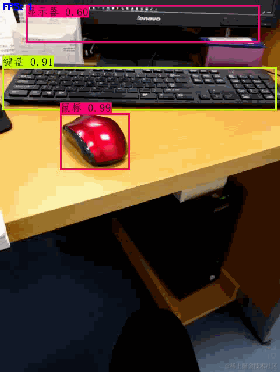我们先来看看什么是物体检测,见下图:

如上图所示, 物体检测就是需要检测出图像中有哪些目标物体,并且框出其在图像中的位置。
本篇文章,我将会介绍如何利用训练好的物体检测模型来快速实现上图的效果,这里我们将会用到基于coco数据集训练的yolov3模型,该模型能识别80类物品,具体如下:
人 自行车 汽车 摩托车 飞机 公共汽车 火车 卡车 船 红绿灯 消防栓 停车标志 停车收费码表 长凳 鸟 猫 狗 马 羊 牛 大象 熊 斑马 长颈鹿
双肩包 雨伞 手提包 领带 手提箱 飞盘 双架滑雪板 滑雪板 球 风筝 棒球棍 棒球手套 滑板 冲浪板 网球拍 瓶子 酒杯 杯子 叉子 刀 勺子 碗
香蕉 苹果 三明治 橙子 西兰花 胡萝卜 热狗 披萨 炸面圈 蛋糕 椅子 沙发 盆栽 床 餐桌 厕所 显示器 笔记本电脑 鼠标 遥控器 键盘 手机
微波炉 电烤箱 烤面包器 水槽 冰箱 书 钟 花瓶 剪刀 泰迪熊 吹风机 牙刷
下面,我们来看具体如何实现。
第一步:从github上下载项目: https://github.com/qqwweee/keras-yolo3
该项目是基于keras的yolov3实现,keras是一个深度学习高层框架,提供了更友好的接口,其底层可以兼容很多深度学习框架,比如tensorflow等。yolo是目前很流行的物体检测算法,yolov3是第三个版本,也是最新的版本。
第二步:安装keras。
通过pip安装即可,如果后续有遇到本地环境没有的包,也通过pip安装就好了(这里假设你已经装好了python的相关环境,并且知道如何使用pip,如果你还不清楚,可以自行网上搜索,过程也不复杂)。
第三步:下载yolov3.weights,这个文件是darknet预训练好的yolov3模型,可以检测coco数据集中涵盖的80类物体。地址:https://pjreddie.com/media/files/yolov3.weights
第四步:执行以下命令,将下载下来的文件转换为keras可以使用的.h5模型文件
python convert.py yolov3.cfg yolov3.weights model_data/yolo.h5
第五步:将项目中的yolo.py,用下面代码替换,注意检查_defaults中的配置路径是否正确
# -*- coding: utf-8 -*-
"""
Class definition of YOLO_v3 style detection model on image and video
"""import colorsys
import os
from timeit import default_timer as timer
import numpy as np
from PIL import Image, ImageFont, ImageDraw
from keras import backend as K
from keras.layers import Input
from keras.models import load_model
from keras.utils import multi_gpu_model
from yolo3.model import yolo_eval, yolo_body, tiny_yolo_body
from yolo3.utils import letterbox_imageclass YOLO(object):_defaults = {"model_path": 'model_data/yolo_weights.h5',"anchors_path": 'model_data/yolo_anchors.txt',"classes_path": 'model_data/coco_classes.txt',"score" : 0.3,"iou" : 0.45,"model_image_size" : (416, 416),"gpu_num" : 0,}@classmethoddef get_defaults(cls, n):if n in cls._defaults:return cls._defaults[n]else:return "Unrecognized attribute name '" + n + "'"def __init__(self, **kwargs):self.__dict__.update(self._defaults) # set up default valuesself.__dict__.update(kwargs) # and update with user overridesself.class_names = self._get_class()self.anchors = self._get_anchors()self.sess = K.get_session()self.boxes, self.scores, self.classes = self.generate()def _get_class(self):classes_path = os.path.expanduser(self.classes_path)with open(classes_path, encoding="utf-8") as f:class_names = f.readlines()class_names = [c.strip() for c in class_names]return class_namesdef _get_anchors(self):anchors_path = os.path.expanduser(self.anchors_path)with open(anchors_path, encoding="utf-8") as f:anchors = f.readline()anchors = [float(x) for x in anchors.split(',')]return np.array(anchors).reshape(-1, 2)def generate(self):model_path = os.path.expanduser(self.model_path)assert model_path.endswith('.h5'), 'Keras model or weights must be a .h5 file.'# Load model, or construct model and load weights.num_anchors = len(self.anchors)num_classes = len(self.class_names)is_tiny_version = num_anchors == 6 # default settingtry:self.yolo_model = load_model(model_path, compile=False)except:self.yolo_model = tiny_yolo_body(Input(shape=(None, None, 3)), num_anchors // 2, num_classes) \if is_tiny_version else yolo_body(Input(shape=(None, None, 3)), num_anchors // 3, num_classes)self.yolo_model.load_weights(self.model_path) # make sure model, anchors and classes matchelse:assert self.yolo_model.layers[-1].output_shape[-1] == \num_anchors / len(self.yolo_model.output) * (num_classes + 5), \'Mismatch between model and given anchor and class sizes'print('{} model, anchors, and classes loaded.'.format(model_path))# Generate colors for drawing bounding boxes.hsv_tuples = [(x / len(self.class_names), 1., 1.)for x in range(len(self.class_names))]self.colors = list(map(lambda x: colorsys.hsv_to_rgb(*x), hsv_tuples))self.colors = list(map(lambda x: (int(x[0] * 255), int(x[1] * 255), int(x[2] * 255)),self.colors))np.random.seed(10101) # Fixed seed for consistent colors across runs.np.random.shuffle(self.colors) # Shuffle colors to decorrelate adjacent classes.np.random.seed(None) # Reset seed to default.# Generate output tensor targets for filtered bounding boxes.self.input_image_shape = K.placeholder(shape=(2,))if self.gpu_num >= 2:self.yolo_model = multi_gpu_model(self.yolo_model, gpus=self.gpu_num)boxes, scores, classes = yolo_eval(self.yolo_model.output, self.anchors,len(self.class_names), self.input_image_shape,score_threshold=self.score, iou_threshold=self.iou)return boxes, scores, classesdef detect_image(self, image):start = timer()if self.model_image_size != (None, None):assert self.model_image_size[0] % 32 == 0, 'Multiples of 32 required'assert self.model_image_size[1] % 32 == 0, 'Multiples of 32 required'boxed_image = letterbox_image(image, tuple(reversed(self.model_image_size)))else:new_image_size = (image.width - (image.width % 32),image.height - (image.height % 32))boxed_image = letterbox_image(image, new_image_size)image_data = np.array(boxed_image, dtype='float32')print(image_data.shape)image_data /= 255.image_data = np.expand_dims(image_data, 0) # Add batch dimension.out_boxes, out_scores, out_classes = self.sess.run([self.boxes, self.scores, self.classes],feed_dict={self.yolo_model.input: image_data,self.input_image_shape: [image.size[1], image.size[0]],K.learning_phase(): 0})print('Found {} boxes for {}'.format(len(out_boxes), 'img'))# font = ImageFont.truetype(font='font/FiraMono-Medium.otf',# size=np.floor(3e-2 * image.size[1] + 0.5).astype('int32'))# 使用中文字体font = ImageFont.truetype(font='font/simfang.ttf',size=np.floor(3e-2 * image.size[1] + 0.5).astype('int32'))thickness = (image.size[0] + image.size[1]) // 300for i, c in reversed(list(enumerate(out_classes))):predicted_class = self.class_names[c]box = out_boxes[i]score = out_scores[i]label = '{} {:.2f}'.format(predicted_class, score)draw = ImageDraw.Draw(image)label_size = draw.textsize(label, font)top, left, bottom, right = boxtop = max(0, np.floor(top + 0.5).astype('int32'))left = max(0, np.floor(left + 0.5).astype('int32'))bottom = min(image.size[1], np.floor(bottom + 0.5).astype('int32'))right = min(image.size[0], np.floor(right + 0.5).astype('int32'))print(label, (left, top), (right, bottom))if top - label_size[1] >= 0:text_origin = np.array([left, top - label_size[1]])else:text_origin = np.array([left, top + 1])# My kingdom for a good redistributable image drawing library.for i in range(thickness):draw.rectangle([left + i, top + i, right - i, bottom - i],outline=self.colors[c])draw.rectangle([tuple(text_origin), tuple(text_origin + label_size)],fill=self.colors[c])draw.text(text_origin, label, fill=(0, 0, 0), font=font)del drawend = timer()print(end - start)return imagedef close_session(self):self.sess.close()def detect_video(yolo, video_path, output_path=""):import cv2vid = cv2.VideoCapture(video_path)if not vid.isOpened():raise IOError("Couldn't open webcam or video")# video_FourCC = int(vid.get(cv2.CAP_PROP_FOURCC))video_FourCC = cv2.VideoWriter_fourcc(*"mp4v")video_fps = vid.get(cv2.CAP_PROP_FPS)video_size = (int(vid.get(cv2.CAP_PROP_FRAME_WIDTH)),int(vid.get(cv2.CAP_PROP_FRAME_HEIGHT)))isOutput = True if output_path != "" else Falseif isOutput:print("!!! TYPE:", type(output_path), type(video_FourCC), type(video_fps), type(video_size))out = cv2.VideoWriter(output_path, video_FourCC, video_fps, video_size)accum_time = 0curr_fps = 0fps = "FPS: ??"prev_time = timer()while True:return_value, frame = vid.read()if return_value:image = Image.fromarray(frame)image = yolo.detect_image(image)result = np.asarray(image)curr_time = timer()exec_time = curr_time - prev_timeprev_time = curr_timeaccum_time = accum_time + exec_timecurr_fps = curr_fps + 1if accum_time > 1:accum_time = accum_time - 1fps = "FPS: " + str(curr_fps)curr_fps = 0cv2.putText(result, text=fps, org=(3, 15), fontFace=cv2.FONT_HERSHEY_SIMPLEX,fontScale=0.50, color=(255, 0, 0), thickness=2)cv2.namedWindow("Object Detect", cv2.WINDOW_NORMAL)cv2.resizeWindow("Object Detect", 640, 480);cv2.imshow("Object Detect", result)if isOutput:print("start write...==========================================================================")out.write(result)if cv2.waitKey(1) & 0xFF == ord('q'):breakelse:breakout.release()vid.release()cv2.destroyAllWindows()yolo.close_session()def for_img(yolo):path = 'images/IMG_0728.JPG'try:image = Image.open(path)except:print('Open Error! Try again!')else:r_image = yolo.detect_image(image)r_image.show()yolo.close_session()def for_video(yolo):detect_video(yolo, "videos/xx.mp4", "videos/xx_detect.mp4")if __name__ == '__main__':_yolo = YOLO()for_img(_yolo)# for_video(_yolo)
本项目是可以在CPU上运行的,但是GPU上运行的更快。关于如何搭建GPU的运行环境,感兴趣的读者可以参考《如何在阿里云租一台GPU服务器做深度学习?》,然后将上面的代码的gpu_num改为你的GPU号(可以使用nvidia-smi命令查看),并注意加入对GPU显存的使用控制即可,这里为了快速体验物体检测效果,就不再对GPU下运行程序做过多的介绍,虽然在CPU下运行会慢很多,但用于体验足够了。
做完上面的步骤后,执行yolo.py,将会看到你想检测的图像的物体检测效果,左边是原图,该图项目中是没有的,可以自行下载,或者用你喜欢的其它图片来尝试检测:

除了图片的检测,还可以对视频进行检测,修改yolo.py中的最后一行,将图片检测注释掉,放开视频检测的注释,然后执行yolo.py即可,下面是检测效果:





—— 数组)
)

面向服务架构设计理论与实践)




![[Android] Android文件系统中存储的内容有哪些?](http://pic.xiahunao.cn/[Android] Android文件系统中存储的内容有哪些?)
)





